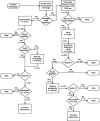Cost-effectiveness of a motivational intervention for alcohol-involved youth in a hospital emergency department
- PMID: 20409432
- PMCID: PMC2859787
- DOI: 10.15288/jsad.2010.71.384
Cost-effectiveness of a motivational intervention for alcohol-involved youth in a hospital emergency department
Abstract
Objective: Brief interventions in the emergency department targeting risk-taking youth show promise to reduce alcohol-related injury. This study models the cost-effectiveness of a motivational interviewing-based intervention relative to brief advice to stop alcohol-related risk behaviors (standard care). Average cost-effectiveness ratios were compared between conditions. In addition, a cost-utility analysis examined the incremental cost of motivational interviewing per quality-adjusted life year gained.
Method: Microcosting methods were used to estimate marginal costs of motivational interviewing and standard care as well as two methods of patient screening: standard emergency-department staff questioning and proactive outreach by counseling staff. Average cost-effectiveness ratios were computed for drinking and driving, injuries, vehicular citations, and negative social consequences. Using estimates of the marginal effect of motivational interviewing in reducing drinking and driving, estimates of traffic fatality risk from drinking-and-driving youth, and national life tables, the societal costs per quality-adjusted life year saved by motivational interviewing relative to standard care were also estimated. Alcohol-attributable traffic fatality risks were estimated using national databases.
Results: Intervention costs per participant were $81 for standard care, $170 for motivational interviewing with standard screening, and $173 for motivational interviewing with proactive screening. The cost-effectiveness ratios for motivational interviewing were more favorable than standard care across all study outcomes and better for men than women. The societal cost per quality-adjusted life year of motivational interviewing was $8,795. Sensitivity analyses indicated that results were robust in terms of variability in parameter estimates.
Conclusions: This brief intervention represents a good societal investment compared with other commonly adopted medical interventions.
Figures


Similar articles
-
The Quik Fix study: a randomised controlled trial of brief interventions for young people with alcohol-related injuries and illnesses accessing emergency department and crisis support care.BMC Emerg Med. 2014 Aug 8;14:19. doi: 10.1186/1471-227X-14-19. BMC Emerg Med. 2014. PMID: 25103779 Free PMC article. Clinical Trial.
-
The efficacy of single-session motivational interviewing in reducing drug consumption and perceptions of drug-related risk and harm among young people: results from a multi-site cluster randomized trial.Addiction. 2004 Jan;99(1):39-52. doi: 10.1111/j.1360-0443.2004.00564.x. Addiction. 2004. PMID: 14678061 Clinical Trial.
-
Cost-effectiveness analysis of motivational interviewing with feedback to reduce drinking among a sample of college students.J Stud Alcohol Drugs. 2012 Mar;73(2):226-37. doi: 10.15288/jsad.2012.73.226. J Stud Alcohol Drugs. 2012. PMID: 22333330 Free PMC article. Clinical Trial.
-
Alcoholics Anonymous and other 12-step programs for alcohol use disorder.Cochrane Database Syst Rev. 2020 Mar 11;3(3):CD012880. doi: 10.1002/14651858.CD012880.pub2. Cochrane Database Syst Rev. 2020. PMID: 32159228 Free PMC article.
-
Brief motivational interviewing interventions targeting substance abuse in the acute care medical setting.Semin Clin Neuropsychiatry. 2003 Jul;8(3):188-96. doi: 10.1016/s1084-3612(03)00025-x. Semin Clin Neuropsychiatry. 2003. PMID: 12874739 Review.
Cited by
-
Can brief alcohol interventions for youth also address concurrent illicit drug use? results from a meta-analysis.J Youth Adolesc. 2015 May;44(5):1011-23. doi: 10.1007/s10964-015-0252-x. Epub 2015 Jan 20. J Youth Adolesc. 2015. PMID: 25600491 Free PMC article.
-
Effects of Brief Alcohol Interventions on Drinking and Driving among Youth: A Systematic Review and Meta-analysis.J Addict Prev. 2015;3(1):11. doi: 10.13188/2330-2178.1000016. J Addict Prev. 2015. PMID: 26221619 Free PMC article.
-
Conducting economic evaluations of screening and brief intervention for hazardous drinking: Methods and evidence to date for informing policy.Drug Alcohol Rev. 2010 Nov;29(6):623-30. doi: 10.1111/j.1465-3362.2010.00238.x. Drug Alcohol Rev. 2010. PMID: 20973847 Free PMC article. Review.
-
Costs of alcohol screening and brief intervention in medical settings: a review of the literature.J Stud Alcohol Drugs. 2012 Nov;73(6):911-9. doi: 10.15288/jsad.2012.73.911. J Stud Alcohol Drugs. 2012. PMID: 23036208 Free PMC article. Review.
-
Motivational counseling reduces future police charges in court referred youth.Accid Anal Prev. 2013 Apr;53:89-99. doi: 10.1016/j.aap.2013.01.006. Epub 2013 Jan 16. Accid Anal Prev. 2013. PMID: 23384442 Free PMC article. Clinical Trial.
References
-
- American College of Surgeons. Resources for the optimal care of injured patient. Chicago, IL: Author; 2006.
-
- Arias E. United States life tables, 2000. National Vital Statistics Reports. 2002;51:1–38. - PubMed
-
- Bauman A, Phongsavan P. Epidemiology of substance use in adolescence: Prevalence, trends and policy implications. Drug and Alcohol Dependence. 1999;55:187–207. - PubMed
-
- Blincoe L, Seay A, Zaloshnja E, Miller T, Romano E, Luchter S, Spicer R. The economic impact of motor vehicle crashes, 2000. Washington, DC: National Highway Traffic Safety Administration; 2002.
-
- Bureau of Labor Statistics. 2008 National occupational employment and wage estimates: Clinical, Counseling, and School Psychologists. 2009a. Retrieved from http://www.bls.gov/oes/2008/may/oesl93031.htm.
Publication types
MeSH terms
Grants and funding
LinkOut - more resources
Full Text Sources
Medical

